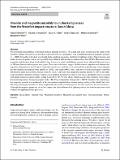Ilmenite and magnetite microfabrics in shocked gneisses from the Vredefort impact structure, South Africa
Author(s)
Dellefant, Fabian; Trepmann, Claudia A.; Gilder, Stuart A.; Sleptsova, Iuliia V.; Kaliwoda, Melanie; Weiss, Benjamin P.; ... Show more Show less
Download410_2022_Article_1950.pdf (21.61Mb)
Publisher with Creative Commons License
Publisher with Creative Commons License
Creative Commons Attribution
Terms of use
Metadata
Show full item recordAbstract
Abstract
We investigated microfabrics of shocked Archean gneisses from two, 10 m-deep drill cores located near the center of the Vredefort impact structure in an area that is characterized by a prominent, long-wavelength negative magnetic anomaly (< − 3000 nT) together with short-wavelength, high-amplitude anomalies attributed to lightning strikes. Planar fractures and feather features in quartz, which can be partially recrystallized, indicate shock conditions less than 20 GPa. Micrometer-sized magnetite and ilmenite along shock-related shear fractures in quartz and feldspar emanate from adjacent deformed coarse (> 100 µm) ilmenite and magnetite host grains. These fine-scaled veins suggest mobilization of magnetite and ilmenite during shear deformation of host Fe-phases and adjacent silicates, probably associated with frictional heating. Coarse ilmenite has fine-lamellar mechanical twins parallel to {10
$$\overline{1}$$
1
¯
1} and single (0001) twins, indicative of dislocation-glide-controlled deformation under non-isostatic stresses related to shock. A few µm-wide magnetite lamellae parallel to {10
$$\overline{1}$$
1
¯
1} and spheroidal magnetite (diameter ≈10 µm) within coarse ilmenite document exsolution after shock. Dauphiné twins associated with planar features in quartz imply cooling from 650 to 725 °C after shock, which accords with estimates of pre-impact basement temperatures from petrographic studies. The Curie temperature of magnetite is 580 °C; therefore, the central negative magnetic anomaly was produced as a thermoremanent magnetization acquired during cooling of the initially hot crust. The long-wavelength anomaly was likely amplified by the newly created magnetite that also acquired a thermal remanence. Although the magnetic properties of surface samples are often influenced by lightning strikes, we found no microstructural evidence for lightning-related processes.
Date issued
2022-09-05Department
Massachusetts Institute of Technology. Department of Earth, Atmospheric, and Planetary SciencesPublisher
Springer Berlin Heidelberg
Citation
Contributions to Mineralogy and Petrology. 2022 Sep 05;177(9):88
Version: Final published version